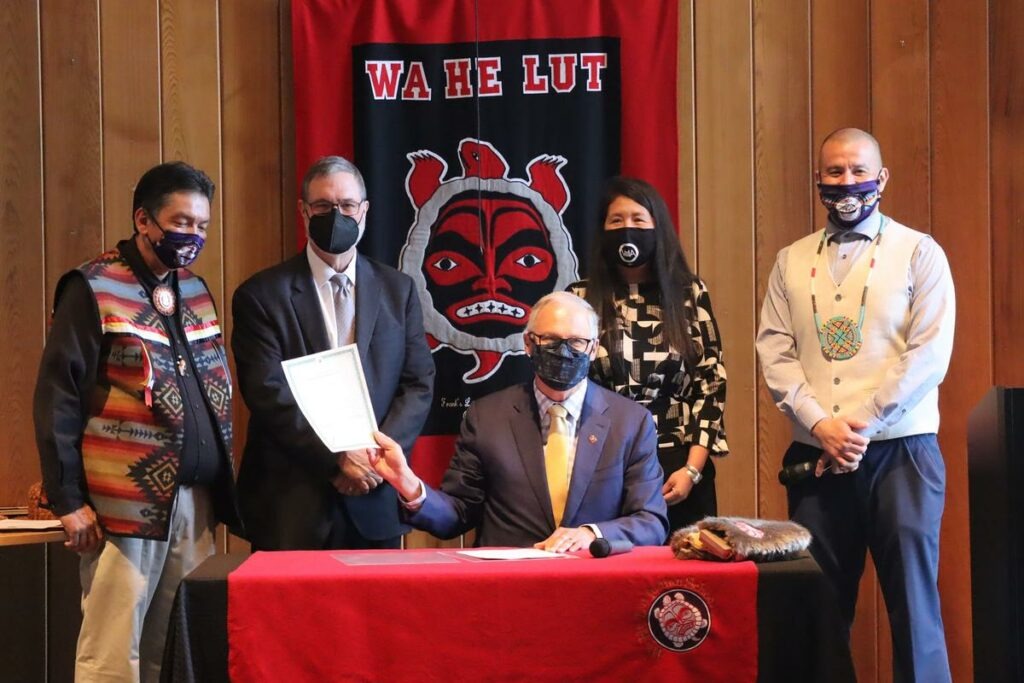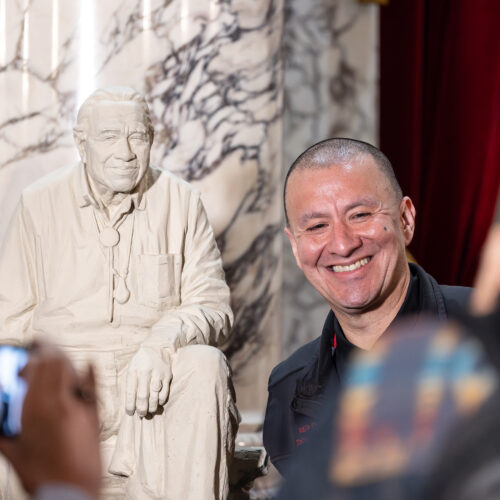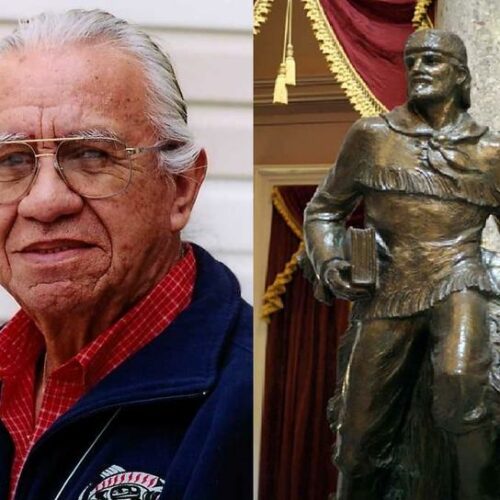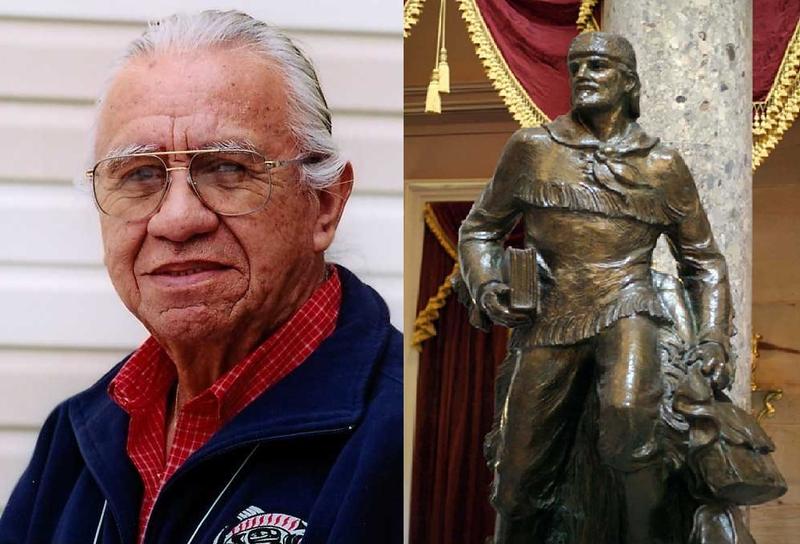
It’s Official: Statue Honoring Billy Frank Jr. To Replace Marcus Whitman At U.S. Capitol
READ ON
In a time of reckoning about historical monuments, Washington state lawmakers found a bipartisan path to change out a prominent statue. A bill signed by Gov. Jay Inslee on Wednesday begins the process of putting a statue of the late tribal treaty rights activist Billy Frank Jr. in the U.S. Capitol.
The Frank statue would replace one of Oregon Trail pioneer Marcus Whitman. The larger-than-life bronze of Whitman has stood in the U.S. Capitol’s Statuary Hall for nearly 70 years.
Each state is allowed to represent itself on Capitol Hill by contributing two bronze or marble historical figures to the national statuary collection.
“We expect to send our best from the state of Washington to be memorialized in the United States Capitol in Statuary Hall,” said Inslee at the bill signing ceremony. “We can’t send the Nisqually River or Mount Rainier, but we can send Billy Frank Jr.”

Billy Frank Jr. poses at Frank’s Landing on the Nisqually River near Olympia on June 29, 2012. CREDIT: Ted. S. Warren/AP
The legislative prime sponsor, Democratic state Rep. Debra Lekanoff, shepherded the bill with a strategy of extolling Frank and never speaking ill of Whitman. Thus, she and her allies avoided antagonizing admirers of the missionary Whitman, whose name adorns landmarks across the Pacific Northwest including many schools, streets, a luxury hotel, a college, a county in eastern Washington, a national forest in Oregon and a glacier on Mount Rainier.
Lekanoff framed the issue as giving a new generation of heroes a chance to stand in a place of honor after the old guard enjoyed many, many decades on a pedestal.
“Billy is a new representative of Washington state to tell the history of what we are today and where we will be in the future,” said Lekanoff, who is the sole Native American currently serving in the state House.
Billy Frank Jr. died in 2014 at the age of 83. In his younger years, the Nisqually tribal member was a self-described “getting arrested guy’” at treaty fishing rights protests. Those “fish-ins” eventually led to what is known as the Boldt Decision, a 1974 federal court case that reaffirmed tribal rights. In later decades, Frank became a widely admired advocate for Northwest salmon and natural resource protection.
“He’d be happy to see this,” said Willie Frank III, speaking of his father, at the bill signing ceremony. “But he’d also tell all of us up here on the stage that we’re not done. We’re a long ways from being done. We have a lot more work to do.”
Inslee signed Lekanoff’s bill at the Wa He Lut Indian School on the banks of the Nisqually River near Olympia. The location was rich in meaning because it was the home ground for Frank’s family. Inslee and other state officials were ushered into the school by Nisqually drummers and singers wearing hand-sewn regalia. Numerous relatives and descendants of Frank attended the signing ceremony and sat beneath a mounted, weathered dugout canoe paddled by their elder when he was young.
No tax money will be used to design and carve or cast the statue of Billy Frank Jr. The Washington Legislature established a large committee to select a sculptor, collect donations and oversee the statue changeover. State fiscal analysts estimated the total costs for the new artwork and the logistics of the swap at around $300,000 to be raised privately.
Legislative support to replace the Whitman statue with one of Frank bridged party lines. The vote in the state House of Representatives was 92-5 followed by passage in the state Senate on a 44-5 vote.
Washington state’s other notable in the U.S. Capitol statuary collection is a 1980 casting of a kneeling figure of Mother Joseph, a 19th century Catholic nun who was responsible for the construction of hospitals, schools and orphanages throughout the Northwest. No one has proposed swapping out Mother Joseph.

Washington Gov. Jay Inslee signed the Billy Frank Jr. statue bill into law at Wa He Lut Indian School on Wednesday. Looking on, from left, were Nisqually Tribal Chairman Ken Choke, Lt. Gov. Denny Heck, state Rep. Debra Lekanoff and tribal councilman Willie Frank III. CREDIT: Tom Banse/N3
What happens to the Whitman statue?
Marcus Whitman and his wife Narcissa helped lead one of the first wagon trains into the Oregon Country in 1836. The establishment of the Whitman Mission in the Walla Walla Valley — followed by his family’s death about a decade later during an attack by a Cayuse band — ushered in waves of additional settlers and then soldiers, all of which upended the lifeways of the indigenous people.
The newly signed legislation directs the governor to transfer the Whitman statue to Walla Walla County once it is removed from the U.S. Capitol. The county is home to the Whitman Mission National Historic Site. The board of county commissioners will have to decide where to put the statue then.
The odd thing about the handover provision is that Walla Walla already has an identical copy of the Marcus Whitman statue. It sits outdoors on a pedestal facing Main Street at the edge of the Whitman College campus. As sculpted by Avard Fairbanks, the buckskin-clad missionary and frontier doctor strikes a heroic pose with Bible in one hand and saddlebags in the other.
Both Republican state Rep. Skyler Rude of Walla Walla — whose suggestion it was — and Lekanoff embraced the vision of “bringing home” the original bronze of Whitman from the U.S. Capitol for an honorable retirement in the valley where he once made his name.
The existing Whitman statue in Walla Walla has been repeatedly vandalized with graffiti and red paint and is the target of an ongoing campaign to be removed. An online petition asserts that the monument celebrates “a history of racialized oppression” and is unworthy of civic honor.
Two sons of the late sculptor Fairbanks wrote to the Walla Walla City Council last fall to object to the possible removal of the existing Whitman statue in that city, which they characterized as “a vain attempt to discredit the great statue.” The letter from Dr. Grant Fairbanks of Salt Lake City went on to say that he would gladly take the monument if it was no longer wanted by the Walla Walla citizenry.
“If those in authority wish to get rid of the statue, please ship it to me and I will erect it on a one-acre plot before Utah’s majestic mountains with a historic church which is to become an Avard T. Fairbanks Sculpture Museum,” the son wrote.
Ready to do this again at the State Capitol?
A third copy of the Marcus Whitman statue stands in an alcove inside the Washington State Capitol about 120 feet away from the door to Inslee’s office. The legislation signed by the governor Wednesday is silent about what, if anything, should happen to this monumental casting.
Lekanoff said she had a follow up bill in mind for a future legislative session which would seek to accomplish a similar statue swap of the buff bronze under the State Capitol dome.
Nine other states have previously swapped out their marble or bronze representation among the U.S. Capitol’s statues. At Virginia’s request, Confederate general Robert E. Lee was removed in December. North Carolina leaders are nearly ready to replace the statue of a race-baiting former governor, Charles Aycock, with a lifelike statue of the evangelist Rev. Billy Graham.
Related Stories:

‘Fish War’ screens in Wenatchee
“Fish War” screens at the Numerica Performing Arts Center on Thursday. (Credit: North Forty Productions) Listen (Runtime 0:56) Read WENATCHEE— A documentary highlighting tribal leaders who stepped forward as environmental

Late tribal leader, Billy Frank Jr., honored at Washington capitol
Emotions flooded the State Reception Room in Olympia Jan. 10 as tribal leaders, Washington lawmakers, and community members came together to witness the unveiling of the maquette of Billy Frank Jr. The maquette, a smaller replica of a 9-foot tall statue of Frank that will go to the National Statuary Hall collection, honors the late champion for Native American treaty rights and natural resources.

Washington Legislature Approves Bill To Honor Billy Frank Jr., Replacing Marcus Whitman At Capitol
A measure to honor the late Billy Frank Jr. with a statue at the U.S. Capitol cleared the Legislature Monday. On a 44-5 bipartisan vote, the Democratic-led Senate approved the bill that seeks to replace Washington’s Marcus Whitman statue in the National Statuary Hall Collection with a statue of Frank, a Nisqually tribal member who championed treaty rights.
















